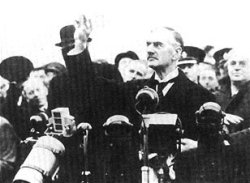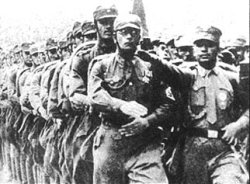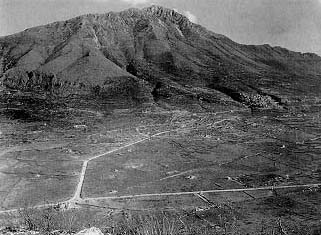 | American War Documentary |
|
Why We Fight - Prelude to War - Frank Capra''s Why We Fight, Prelude to War. A Dramatic study on Film of evants leading up to WWII. A Look at the contrasts between free socoeties and totalitarian governments. This series Prelude yo War, Won an Oscar fro best Documentary. |
The Nazis Strike - The Nazis come to power. Hitler imposes full dictatorship on Germany. The Nazis march on Austria and Czechoslovakia and invade Poland. Appeasement attempts are made, but it is soon evident that the curtain is about to rise on World War II. |
San Pietro - http://history.sandiego.edu/gen/filmnotes/sanpietro.html (š▄▐čę╬═, ─Ų╬═ - http://www.krugosvet.ru/articles/30/1003086/print.htm) |
Prelude to War:
Why are were fighting?
What put us into uniform?
What of these two worlds?
How did it become free?
What of this other world?
And what of our world?
Prelude to War was the first entry in the US War Department''s Why We Fight series, a group of seven morale-boosing documentaries supervised by Lt. Col. Frank Capra. As brilliantly assembled as any of Capra''s "populist" Hollywood films, Prelude demonstrates how the diplomatic and political blunders made in the wake of WW1 led inexorably to WW2. Especially culpable are those complacent citizens of the USA who were led to believe that the problems of the rest of the world had no bearing on their lives. While America sleeps, Japan and Germany slowly and methodically build their armies and launch their plans for global conquest. Throughout the film, the lies of fascisim and totalitarinism are contrasted with the ideals of Democracy. Unlike most other War Department efforts, the 53-minute Why We Fight was shown to both civilian and military audiences.
Plot Synopsis: This famous propaganda piece, used as a U.S. Army training film in WWII before theatrical release, asks ''why we fight.'' The answer compares the ''free'' and ''slave'' worlds. Included: development of dictatorships in Italy, Germany and Japan, while anti-militarism and isolationism rise in the USA; a look at enemy propaganda; and the first acts of aggression. Walter Huston narrates a combination of archival footage, maps, and other graphics.
"Prelude to War," Chapter I of Frank Capra''s "Why We Fight" series,
describes World War II as a battle between the "slave world" of fascism
and the "free world" of American liberty. In the "slave world," the
entire populations of Germany, Italy and Japan have been hoodwinked by
madmen, opportunists who capitalized on their people''s desperation and
weakness to rise to power. These demagogues promised revenge for past
losses, and in the process convinced their people to give up their
rights and accept dictatorship. In the "free world," the principles of
equality, freedom, and liberty characterize the greatest leaders,
embodied in the works and words of Washington, Jefferson, and Lincoln.
This freedom is a threat to the fascist dictators of the Axis powers,
who claim that democracy is weak and must be eradicated. The film
claims that the ultimate goal of the Axis powers is to enslave the
nations of the "free world," a desire made manifest in the Japanese
invasion of Manchuria and Mussolini''s destruction of Ethiopia.
As you probably know, the "Why We Fight" series was produced by Frank Capra when he was a major in the U.S. Army Signal Corps. The series was commissioned by Army Chief of Staff, General George C. Marshall, as a way of indoctrinating all the troops who signed up in the wake of Pearl Harbor and the declaration of war. The idea was to make it clear we were doing more than just remembering Pearl Harbor. Eventually the series was shown to the public in theaters across the country. This introductory film in the "Why We Fight" series covers the events leading up to the Second World War, focusing on the rise of Fascism in Italy and Germany, the Japanese attacks on Manchuria, and the United States'' lack of military preparedness. The last is particularly interesting because it implicitly explains Pearl Harbor not as a Japanese victory, but rather as an American defeat (we lost rather than they won). "Prelude to War" defines World War II in black and white terms as the totalitarian worldwide conspiracy threatens to turn the free world into a slave world. Admittedly a propaganda film, this 1942 documentary is quite informative, explaining about Hitler''s book "Mein Kampf," Lebensraum, the Tanaka Plan, the London Naval Treaty, the Kellogg-Briand Pact, the Nuremberg Laws, and even such details as the Roman fasces.
This 54-minute black & white film won the Academy Award for best documentary in 1942 and the series as a whole is credited with redefining the documentary as an art form. Of great historical value, it must be underscored that "Prelude to War" is not exactly propaganda in the most pejorative sense of the term. The film''s great "sin" along those lines is that it makes the case that public opinion was moving in the direction of joining the war. Instead of dismissing this film and Capra''s efforts as the American counterpart to what Goebbels was doing in Nazi Germany, it is more accurate to think of it as being the film equivalent of a prosecutor''s speech in a trial. "Prelude to War" makes much better use of evidence without the radical distortion you usually find in classic examples of propaganda.
"The Battle of San Pietro (originally titled simply San Pietro) builds into the greatest of combat documentaries, unmatched in evoking the physicality and human price of war. It''s at once factual and inspirational, harrowing and tender. It''s filled with eloquent words and with images that defy words...San Pietro combines astonishing actuality footage with one of the most memorable voice-over narrations in film--both in script and delivery. James Agee characterized it best in his 1945 Nation review: "Huston''s narration is a slightly simplified technical prose, at once exact and beautifully toned and subtly parodistic; it is spoken with finely shaded irony, equally free of pompousness and optimism and mawkish generalizations and cheap bitterness.... For once wordiness in a film more than earns its way." When the army reaches the village of San Pietro itself, even these words fall silent before images of bodies unearthed from rubble and children''s resilient faces...Some recent critics have expressed shock on discovering that San Pietro is carefully crafted and not the compilation of artless footage that some associate with truth in documentary. The battle sequences have a handheld, cinema-verite look, but careful viewers will notice, for instance, the oddly large number of apparently left-handed soldiers. Evidently Huston flipped some shots to make the soldiers'' screen movements correspond to the east-to-west attack on the maps: "We" always attack from right-to-left, "the enemy'' from left-to-right. Huston also restaged more footage than his end title admits. But accurate facts about this particular battle are marshaled into an authentic argument about valor in combat... After shots of soldiers'' dog tags nailed to rough wooden grave markers, we see survivors smiling wearily, but the voice-over undercuts the relaxed moment: "Many among those you see alive here have since joined the ranks of their brothers-in-arms who fell at San Pietro.... Ahead lay ... more San Pietros, greater or lesser, a thousand more." What is most uncompromising about San Pietro among combat documentaries is its refusal to claim that the battle we''ve experienced in such detail was in any way distinctive or decisive, and thus its refusal to bestow special military significance on the soldiers'' sacrifice. Tacked on to dispute this view is the two-minute introduction by Gen. Mark Clark, commander of the Italian campaign. Looking ill-at-ease, General Clark claims San Pietro was "key'' to the region and that the "cost" in deaths "was not excessive." The complaint voiced against the film by the army brass was most simply that "this picture is pacifistic. It''s against war, against the war." Huston responded that he made the film in profound admiration for the courage of the foot soldier, but he also said, "Well, sir, whenever I make a picture that''s for war--why, I hope you take me out and shoot me."
Let There Be Light is about the post-traumatic, the frigid chamber of horror that contains the memories that come after the white-hot horrors of battle or - worse - in expectation of battle - http://www.sensesofcinema.com/contents/cteq/00/6/light.html
7 films of Frank Capra
Frank Capra
Wiki about Prelude to War
"The Nazis Strike"- symposium
Huston, John (1906¢1987)


